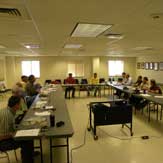Demonstrating Conservation Tillage Methods and Benefits Under Furrow Irrigation:
A Collaborative Project with Conservation District, Industry, Producer, and University Participation
Why Conservation Tillage in Furrow Irrigated Fields?
Traditional practices in furrow irrigation involve multiple, energy consuming tillage operations intended to loosen soil, bury residue, smooth and level soil surfaces, and create a suitable seedbed. However, these systems leave the bare soil surface vulnerable to wind and water erosion before the crop canopy is developed and during seasonal periods where weather conditions are often most conducive to soil loss. Tradition and legitimate concerns regarding irrigation performance help continue these outdated practices. Residue, often called ‘trash’ by many farmers, can cause furrow ‘dams’ during irrigation, limiting irrigation uniformity. Cool spring soil temperatures can limit early plant growth and disease concerns with certain crops also limit widespread adoption.
However, recent developments in planting and tillage system technologies are offering more options for successfully dealing with crop residue during planting and cool soil temperature in furrow irrigated systems. These tillage systems, coupled with more accurate and economical Global Positioning Systems (GPS) are gaining widespread acceptance in certain parts of the Western Great Plains and Colorado, but are much less common in the upper S. Platte Valley.
Conservation tillage in furrow irrigation is not only possible, but offers many agronomic, economic and environmental benefits. First, the benefits of soil moisture preservation with increased crop residue in many environments and cropping systems are well known and documented for many years. Soil erosion prevention from both wind and water with increased residue is also a proven benefit (Troeh et al. 2004). Erosion reduction from conservation tillage in furrow irrigation system occurs not only prior to the irrigation season, but also during furrow irrigation by decreasing irrigation induced sediment loss and increasing infiltration (Pearson et al. 2002).
Location:
The project will have at least three field sites in the Northern Front Range of Colorado (Figure 1). The first site will be at the Colorado State University Agricultural Research, Development and Education Center (ARDEC) on a fourteen acre field. Demonstrations are also being carried out on-farm with Northern Colorado producers already working with some type of conservation tillage. It is possible that demonstration sites in other parts of the state will be incorporated where local interest is strong.
Project Goals and Outputs:
- Field demonstration and evaluation of conservation tillage systems
- Documentation and comparison of cropping inputs, including energy, fertilization requirements, weed control, labor, and equipment costs between tillage systems
- Comparison of water quality (N, P, and sediment) in runoff between systems
- Monitor crop, water, and soil conditions in each system
- Economics of conservation tillage systems
- Utilization of dynamic and innovative outreach mechanisms



